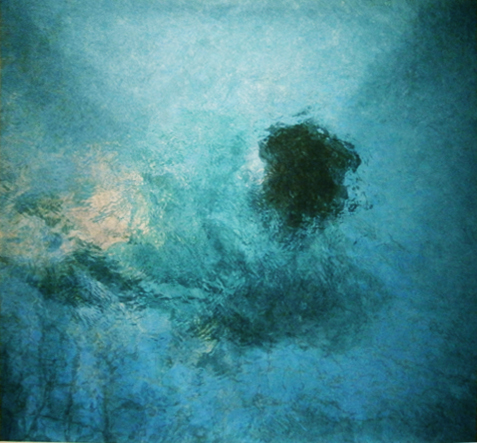
These sensuous works are breathtakingly dramatic, commensurate with a pared down opera scene. They sing visually, calling out a profound metaphysical story. The photo of a drowning girl in Korean traditional dress that billows out in the water, has connotations of national disaster in the wake of the sinking of a fully booked ferry transporting young people home from a group trip. The presiding government gave the matter little attention, which added acutely to the national pain. The descending female in the photo signifies the plummeting national respect held by the Korean people for their government.
A clothed figure presents a more complex inscrutable image than a nude form with its attendant sensual implications. Light that hugs the dark tiled waters defines the mysterious web-like environment that surrounds the prone floating female. The rich rippling forms hold the viewer hostage to their compelling complexities. As a body floats, displacement in the water transports unexpected depths to the surface, reenergizing the waters of the psyche as cold currents descend (The Book of Symbols, Water, P. 38). The light in "Limbo-Beatrice," (pigment print on Korean paper, 145 cm x 200 cm, 2017) conveys the millions of stars in the galaxy that may soon become her future abode. Her blue voluminous dress conjures spiritual ties that keep her body afloat just beneath the water’s surface. Blue is the color of the sky and the sea. In the Christian religion it refers to the Virgin Mary as a regenerative mother figure. Water hints at fertility and refreshment as a source of sustained renewal.

Art can be unfathomable; here there is a force that forges far beyond a Sunday religious experience into an unnamable domain where philosophical musings reach their boundaries. These works begin to flow into an allegorical realm in which water is both damning and cleansing. They convey us through the phases of life's slippery slope, where eventually there is no return. We go forward, or down into a place we created out of our own volition, in a life of constant enticement that is too strong to resist. I interpret these works as metaphorical stages, or incidences of temptation that confront us universally in all our lives. The outcomes we create from our decisions are documented in the liquid grave-like confines that flow in perpetuity with energy and life. In alchemical lore, the mercurial sea symbolizes the function of female transformational powers; drowning in volatile liquid is linked to amniotic fluid that suggests the "stage before a state of rebirth, death and the first gasp of breath." (The Book of Symbols, Water p. 33)
When photography was initially invented, figurative artists feared they would become outdated as photography so readily captures the visual reality of the physical world. But artists like to put their own stamp on their visions and processes. Perhaps it is not perceived as challenging or fulfilling to merely snap a picture. The photographs on view are anything but easy. They are profound symbolic representations of life as we progress toward our eternal fate. They are more like atmospheric paintings than paintings themselves. Such is the kaleidoscopic evolution of the individual artist as he carves his way through the tangled maze of art history to find and make his own enduring mark on his genre. Kang succeeds emphatically.
